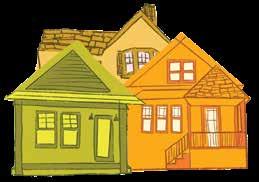
6 minute read
How the Building of I-43 Destroyed Milwaukee's Black Community
Illustration by Ali Bachmann
HOW THE BUILDING OF I-43 DESTROYED MILWAUKEE’S BLACK COMMUNITY
Advertisement
By Michael Carriere
Few developments have been more important to the evolution of Milwaukee than the region’s highway system. The construction of Interstate 94 (I-94) and Interstate 43 (I-43) throughout the 1960s brought a newfound sense of mobility to the residents of metropolitan Milwaukee. As more and more individuals bought cars, the highway came to symbolize both modernity and movement. Milwaukeeans, like others across the nation, were a people on the move by the mid-1960s.
For many such individuals, these highways made the migration to the city’s suburbs, and travel between such places and the city itself, remarkably convenient. Over the late 20th century, both people and businesses used these transportation networks to migrate to these burgeoning suburbs, with each taking valuable tax dollars with them. Such movements signaled the onset of a fiscal crisis in Milwaukee, a development that hurt those that couldn’t make the move to suburbia, namely the city’s growing African American population. Communities of color were left to deal with the repercussions of such acts of divestment.

These very same communities of color—often portrayed, through the use of variety of racist tropes, as “blighted” sections of the cities that highways allowed affluent whites to avoid—also suffered when it came to where these transportation routes were to be placed. As longtime Milwaukee housing activist Jeff Eagan points out, highway planners “targeted the African-American community, where the political clout was the weakest.” In other words, these highways had to be built somewhere—and that somewhere was often right through North Side, African American neighborhoods. Estimates suggest that the construction of I-43 throughout the 1960s led to the demolition of roughly 17,000 homes and close to 1,000 businesses.
Displaced People
Tellingly, no one in municipal government took the lead in relocating those displaced by highway construction. Mayor Henry Maier saw the need for such assistance, but he did not allocate any funding to aid those hurt by displacement, nor did he advocate for open housing throughout the city. Leonard Zubrensky, a member of the city’s Expressway Commission, did suggest that highway construction may have to be delayed until this issue of displacement was properly addressed. But he did not speak up until 1968, well after many Milwaukeeans had already been removed from their homes. During that same year, renters forced to relocate continued to receive no compensation for moving costs.
The broad contours of this story of highway construction—as it played out in Milwaukee and other major U.S. cities—is now well known. Yet, what is less discussed is the impact it had on those that had to live through it. On the macro level, this process turned communities of color into multi-year construction zones. The act of tearing down a structure is a noisy, violent process; imagine witnessing such destruction daily for years. Economic activity

ground to a halt in such neighborhoods, while people struggled to find new housing wherever they could. This often compelled both individuals and families to move outside of the immediate communities they previously called home.

Here, one begins to see a source of individual trauma that cities like Milwaukee have never fully addressed. For community leaders like Jerrel Jones, the founder and publisher of The Milwaukee Courier, a feeling of defenselessness came to inform this moment, as the African American community had little say in how the planning process played out. “We weren’t asked any questions,” notes Jones. “They came and did it.” Speaking on those that carried out this planning process, longtime activist James Nelson, who moved to Milwaukee from Chicago in 1958, refers to them as “like gangsters, they were like bullies.” As he watched the construction proceed, he “felt helpless. You felt how vulnerable you were.”
Tearing the Social Fabric
This feeling of vulnerability was compounded by the fact that these new roads tore apart the social fabric of these neighborhoods while undercutting the very institutions that supported residents. Nelson remembers biking and walking to neighborhood stores that sold things like candy and fruit. Many of these stores closed, while the construction of the highway made it more and more difficult to walk in such neighborhoods; the car now reigned supreme as the primary mode of transportation. Commenting on such disruptions to a once-vibrant streetscape, Jones can only conclude that highway construction “like a cancer… destroyed a culture.”

Nowhere is this destruction of the social fabric wrought by highway construction— and the subsequent depletion of the social capital that often undergirds this fabric— more apparent than in the impact of relocation on personal relationships. To Nelson, an individual forced to relocate was like “a prisoner of war, a refugee.” For him, such construction “affected your friendships directly.” Nelson recalls biking to visit a friend who lived near Eighth Street and Keefe Avenue during the mid-1960s. He had not seen the boy for quite some time, so he was particularly excited to play with him. “I remember coming back and looking for my friend,” remembers Nelson, “and his house was gone.” Ten years old at the time, Nelson never saw his friend again.
NOWHERE IS THIS DESTRUCTION OF THE SOCIAL FABRIC WROUGHT BY HIGHWAY CONSTRUCTION—AND THE SUBSEQUENT DEPLETION OF THE SOCIAL CAPITAL THAT OFTEN UNDERGIRDS THIS FABRIC—MORE APPARENT THAN IN THE IMPACT OF RELOCATION ON PERSONAL RELATIONSHIPS.
It is hard to quantify such pain, to try to understand just how many times a similar story played out in Milwaukee during this era. Yet, there is no denying the fact that such pain remains remarkably real. “I remember playing in that area that is no more,” notes Charles Walton, the son of civil rights activist Jeannetta Simpson-Robinson, “and I think about it each time I travel on I-43 through the African American community.” Some 50 years later, Walton inherently understands the violence that the highway brought to his neighborhood.
Marching on Highways
In the aftermath of the George Floyd killing, protesters around the world have taken to the streets to protest police misconduct. In Milwaukee—as in several other U.S. cities—protesters have marched on highways, shutting down these vast avenues of transit, often for hours at a time. For movement sympathizers and non-sympathizers alike, such a strategy often evokes a strong response. Such a decision, one that impacts so many people, seems to defray attention from the very individualized, very personal type of violence that took the life of George Floyd. The sheer spectacle of shutting down these important traffic routes, such an argument suggests, obscures more than it reveals.
This conclusion misses how much the very setting of these protests—the highway system—is intimately connected to the type of violence that ultimately took George Floyd’s life. In fact, in cities like Minneapolis and Milwaukee (among countless others), the construction of these thoroughfares was an act of violence in and of itself, a type of violence that literally tore through and disembodied neighborhoods of color in cities across the United States. This violence, while not as urgent as a knee to the neck, led to both immediate pain and long-term trauma in communities that suffered the damage wrought by highway construction. Construction begat forced movement, which tore apart both personal and economic relationships. Such damage begat greater divestment, which served to further segregate large swaths of the city along racial and economic lines. And this divestment made it difficult to attract any sort of formal financial investment, a development which did attract the attention of at least one municipal authority in city after city: the police department.
Michael Carrier is an associate professor in the Milwaukee School of Engineering’s humanities department.













